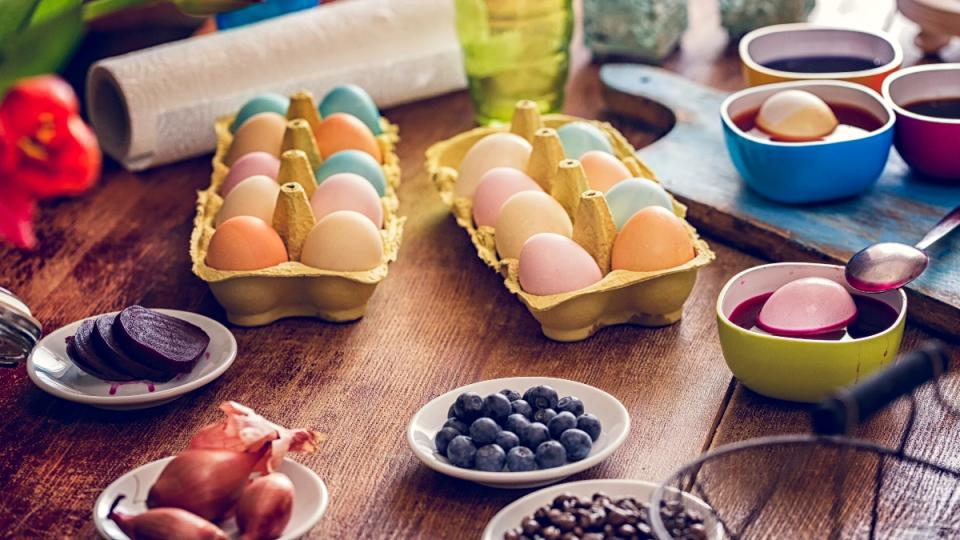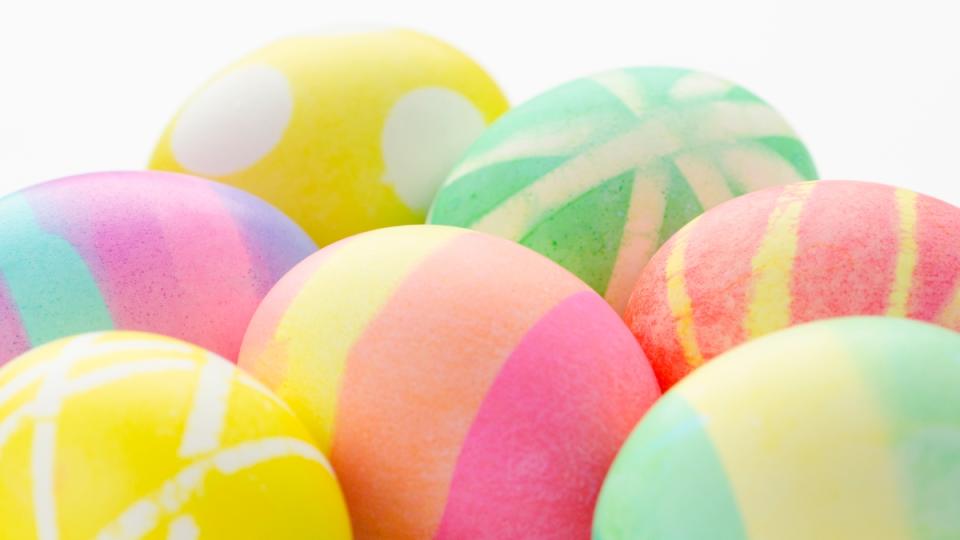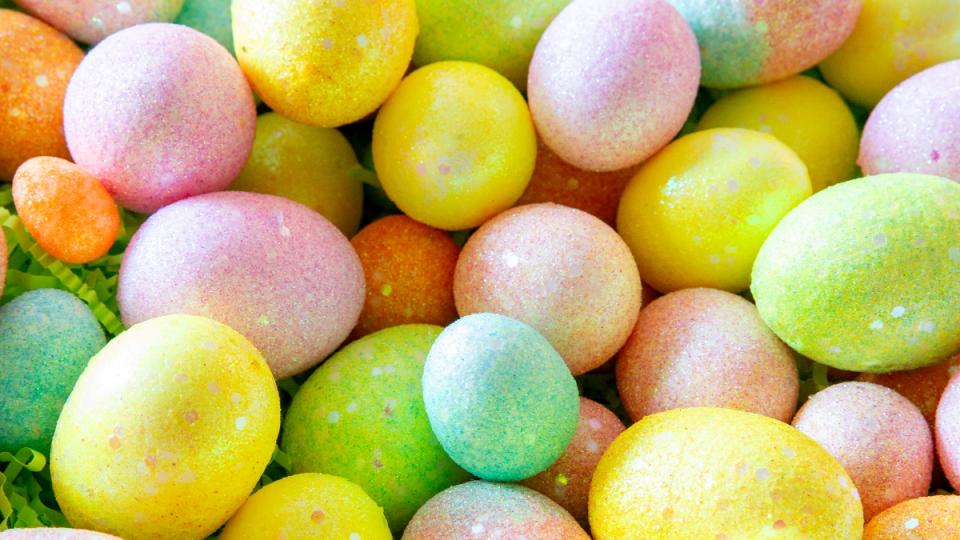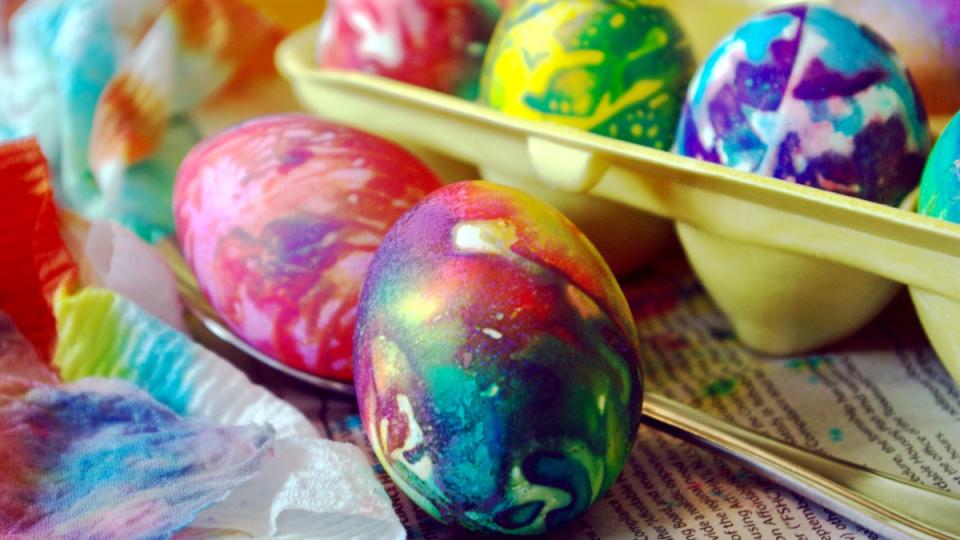4 Fun New Ways to Dye Easter Eggs, Plus How to Make Your Own Natural Dye
For many people, coloring Easter eggs is a must for the holiday. The activity is believed to date back to the Christians of Mesopotamia and has become a popular tradition for children and adults alike. It’s a great way to unleash creativity and make vibrant eggs that are fun to hide (and eat!). And while store-bought egg-dyeing kits make it a cinch to color eggs for Easter, it's also fun to make your own dyes. We rounded up the best tips for making your egg dyeing experience a breeze. Below you’ll find clever Easter egg ideas using homemade and all-natural dyes!
How to make your own dyes for Easter eggs

If you want to save money, need more color options or simply forgot to buy a kit, you can make your own dye right at home. Here, a few simple methods.
1. Use food coloring
To do: Combine 4 drops of food coloring with 1 cup of boiling water, then stir in 1 tsp. of white vinegar to lock in the color. Repeat for each color.
For pastel eggs, the key is in how long you soak the egg! Leaving them in the dye for 30 seconds to two minutes can give you a light but pretty shade.
If the color isn't as vibrant as you'd like, simply leave the egg in the dye longer (at least five minutes) or add in more food coloring. You can also experiment with mixing colors to achieve unique shades. For example, use more blue drops than green to get turquoise.
2. Use fruit juice
Store-bought fruit juice is a quick and easy way to give your eggs a deep color shade. Simply use 1⁄4 cup of juice per color. Choose grape juice to get purple or blue, cranberry for pink eggs and tomato juice for red.
Having trouble getting the color to adhere to the eggshell? Mix in 1/2 tsp. of white vinegar with each juice.
3. Use common foods
The possibilities for ingredients are endless! Lindsey Chastain, who shares homesteading tips on her website, The Waddle and Cluck, loves using everything from beets to spinach for her Easter eggs.
“Beets give eggs a hot pink or magenta tone that looks amazing,” she says. “Turmeric becomes a sunshine yellow that reminds me of spring and renewal. Blueberries, red cabbage, and red onions produce pastel blue, violet and pink eggs. Spinach turns into an earthy green that looks fresh and organic.”
Tips for using natural dyes
White or light-colored eggs work best for natural dyes, as the allow the dyes to appear more vividly. What's more, says Chastain. “The hard-boiled eggs should be room temperature before dyeing with natural dyes. Eggs removed from the fridge and immediately dyed will sweat as they warm up, ruining the dye.” Finally, she adds, make sure your eggs are dry and free from oil. (Click through for how to keep boiled eggs from cracking while cooking.)
For each color you want to make, Chastain says to place your ingredient of choice in a saucepan and add enough water to cover it by 1”. Bring the mixture to a boil, then reduce the heat to simmer for 15 to 30 minutes. Next, remove the pan from the heat and let the dye bath cool to room temperature. Strain into a jar or bowl.
Ready to dye? “Let the eggs soak longer in natural dyes than synthetic ones, 30 minutes or more, depending on the desired intensity,” advises Chastain. “For each cup of dye liquid, add 1 Tbs. of white vinegar and a pinch of salt to help the dye hold.”
For more tips on using natural dyes on your Easter eggs, visit Chastain’s post.
4 creative ways to dye eggs
No matter how you color your eggs, you can create stunning designs on them! Try one of these clever tricks to make dyed eggs even more impressive!
1. Patterned eggs

One of the easiest ways to make dyed eggs look wow-worthy is to create a pattern! This can be achieved using a number of household items. For example, Sarah Johnson (EssyJae) on YouTube shares how useful small adhesive dots (like those sold in the office supplies section) can be.
Just place them over the surface of the egg, dye it as normal, then peel off the stickers once the egg is dry. “You end up with a polka dotted egg,” she says in the video.
Johnson also suggests wrapping pieces of painters tape around the egg before dyeing to create a pretty stripped pattern. See the rest of her tips in the video below:
Another easy design to try: Cut out 6"-long strips of lace, tightly wrap the eggs once and secure with a rubber band (there should be extra lace so you can hold on to the egg). Dye as normal, then unwrap the eggs and let dry. The dye will seep through the lace’s holes, leaving a pretty pattern.
2. Tie-dye eggs

You love multi-colored Easter eggs, but trying to dip them into multiple dyes usually leads to a bleeding of colors and a nearly brown egg!
For a cool effect without having to dip the eggs, try a tie-dye method shared by @rebeccabrackett on TikTok. First, she wraps each egg in a paper towel and secures with a rubber band.
Then while wearing gloves, she places dots of food coloring onto the paper towel. After spritzing with water and letting the eggs sit overnight, you'll find them covered in a tie dye pattern!
See this in action in her video below:
3. Speckled eggs

Dyeing eggs can certainly be a messy business, but it doesn’t have to be! (Need to remove dye from kitchen surfaces? Try these cleaning tricks). In this video from @allaboutthemom on TikTok, she shows how you can get colored, speckled eggs in no time.
Her easy how-to: Pour a cup of rice into a Ziploc bag, add 5 to 6 drops of food coloring and shake it up. Then add the egg to the bag, seal it and shake it up. You’ll get spectacular results without needing to clean up splattered dye.
4. Color swirled eggs

The tie dye method above isn’t the only way to get impressive multi-colored eggs! You can create works of art with the Cool Whip method showcased by ywmfamily on TikTok.
First, let your boiled eggs soak in vinegar for five minutes. Next, add an entire tub of Cool Whip to a large pan, add drops of food coloring and swirl around with a spoon. Put the eggs inside the pan and let them sit for five minutes on each side.
“Then you’re going to transfer to tin foil, let them soak another 10 minutes,” she explains. “You want that color to absorb. Rinse, and they turn out so pretty!”
Admire the end result in her video below:
For more Easter ideas, keep reading!
Easter Brunch: 15 Ideas the Whole Family Will Love
Easter Basket Ideas: Gifts for Babies, Toddlers, Teens, Adults, and More!
How to Roast a Leg of Lamb That’s Juicy + Flavorful for Easter Dinner — Easy Recipe

